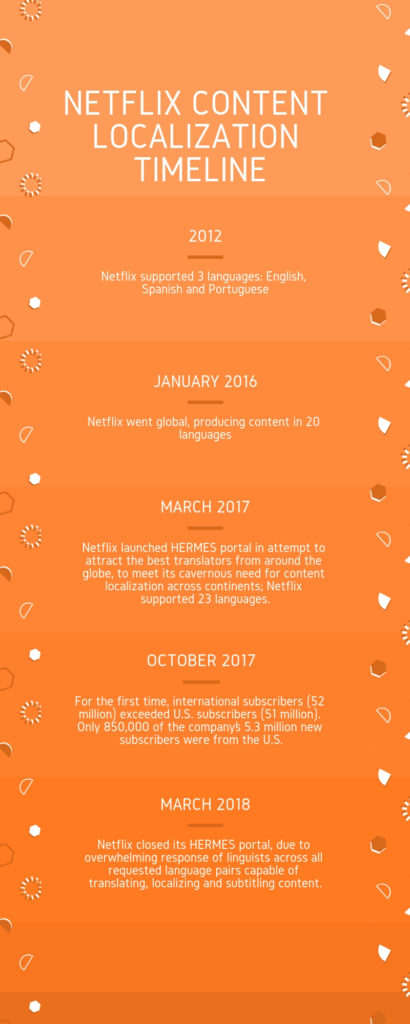HERMES was a flash in the pan for Netflix’s growing translation needs. Now what?
When Netflix went global in 2016, it knew it was going to need one service in a huge way – translation. The global content streaming giant that began as an online movie rental site in the late 90s was preparing to launch its service into 130 countries simultaneously. The need for professional linguists across the globe was huge; the time was fast approaching when English would no longer be the primary viewing experience on Netflix, the media giant predicted. Forbes estimated that more than half of Netflix’s revenues would come from its international market base by 2023.
But a global expansion would require an untold amount of content localization and translation of new material in multiple languages. Who would fill that void, and how?

Enter HERMES, an impressive online portal the company developed in effort to produce content in 20 languages. Through HERMES, Netflix sought the best translators from around the globe to make its content accessible – and enjoyable – to viewers from China to Spain, from Mexico to India.
“Our desire to delight members in ‘their’ language, while staying true to creative intent and mindful of cultural nuances is important to ensure quality. It’s also fueling a need to rapidly add great talent who can help provide top-notch translations for our global members across all of these languages,” Chris Fetner and Denny Sheehan wrote on the Netflix Technology blog in March 2017, the same month the company launched HERMES.
Moravia called it the “most aggressive localization effort in history.”
HERMES was to be the first online subtitling and translation test and indexing system established by a major content creator. The test was broken into 5 phases and required about 90 minutes to complete. HERMES challenged the world’s translators to test their chops. Hefty rounds of testing provided multiple choice questions, designed to gauge the linguist’s ability to:
- Understand English
- Translate idiomatic phrases into their target language
- Identify linguistic and technical errors
- Subtitle
Netflix especially sought individuals with subtitling background. Certainly, the company was interested in creating new shows that catered to viewers in specific regions and cultures. But producing new content from the ground up costs more than translating readily available content. That’s why the media giant was so interested in attracting translators with a knack for subtitling – millions of hours of scripts for movies and shows already existed.
Through HERMES, Netflix aimed to have a standardized test for media translation professionals across the globe. No such test had ever existed, “even though their work touches millions of people’s lives on a daily basis,” Fetner and Sheehan wrote.
Once a linguist passed the test, he/she would be assigned an “H Number.” All of the linguist’s work would be tied to his/her number, and the more work he/she did, the more metrics his/her H Number would show. Netflix hoped the metrics would assist in recommendations over time, using data from past performance to effectively “recommend” the best subtitler for a given show. Attempting to match projects with appropriate linguists would occur much the same way Netflix attempts to match specific shows to its subscribers.
But there was a persistent problem.
Netflix had seemingly built the standardized test for media translation professionals it had envisioned. But how would that system be managed and maintained?
Netflix flooded the market with translation needs. And linguists stepped up. Within two weeks of the HERMES launch, thousands of linguists had responded, representing all language pairs Netflix was seeking. By mid-2017, Netflix supported content in 23 languages.
Then, in March of 2018, Netflix abruptly closed its HERMES portal, issuing an official statement on its website.
Netflix admitted that the HERMES project was overly ambitious in its goal. Better for the global content streamer to stay focused on its core strengths – content workflow, engineering and development – and leave the translation project management, including subtitling and dubbing, to the language service providers it had, until HERMES, loyally worked with.
Netflix, a global media giant, showed the world an example on a grand scale: Stick to what you’re good at, and allow others the opportunity to do the same.
That HERMES is no more in no way suggests a slow in the demand for content localization across languages. In fact, Netflix’s international subscriber base exceeded its U.S. subscriber base by one million at the end of 2017, Slator reported. Of its 5.3 million new subscribers, only 850,000 were from the U.S.
That means the need for qualified linguists – in content creation and in subtitling – is substantial. You just won’t find it on a highly specialized platform. You might look closer to home, instead.














